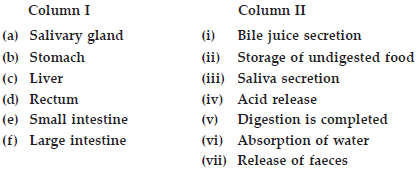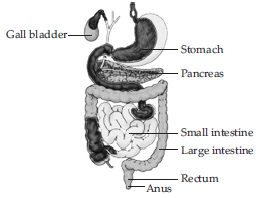Nutrition in Animals (Biology) Class 7 - NCERT Questions
Fill in the blanks :
(A) The main steps of nutrition in humans are ______, ______, ______, ______ and ______.
(B) The largest gland in the human body is ________.
(C) The stomach releases hydrochloric acid and ________ juices which act on food.
(D) The inner wall of the small intestine has many finger - like outgrowths called ________.
(E) Amoeba digests its food in the __________.
(A) ingestion, digestion, absorption, assimilation, egestion (B) liver (C) digestive (D) villi (E) food vacuole
Q 2.Mark ‘T’ if the statement is true and ‘F’ if it is false :
(A) Digestion of starch starts in the stomach. (T/F)
(B) The tongue helps in mixing food with saliva. (T/F)
(C) The gall bladder temporarily stores bile (T/F)
(D) The ruminants bring back swallowed grass into their mouth and chew it for some time. (T/F)
(A) F. Digestion of starch starts in mouth by the action of salivary amylase.
(B) T
(C) T
(D) T
Tick  mark the correct answer in each of the following :
mark the correct answer in each of the following :
(A) Fat is completely digested in the
(i) stomach (ii) mouth (iii) small intestine (iv) large intestine.
(B) Water from the undigested food is absorbed mainly in the
(i) stomach (ii) food pipe (iii) small intestine (iv) large intestine


Match the items of Column I with those given in Column II :


What are villi? What is their location and function?
SOLUTION:Villi are small finger-like projections located in the inner wall of small intestine. Villi increase the surface area of intestine for the absorption of digested food. Each villus has a network of thin and small blood vessels close to its surface. The surface of the villus absorbs the digested food materials. The absorbed substances are transported via the blood vessels to different organs of the
Q 6.Where is the bile produced? Which component of the food does it help to digest
SOLUTION:Bile is produced by the liver and is stored temporarily in the gall bladder. The bile plays an important role in the digestion of fats.
Q 7.Name the type of carbohydrate that can be digested by ruminants but not by humans? Give the reason also.
SOLUTION:Cellulose is a type of carbohydrate that can be digested by ruminants but not by humans. The cellulose of the food is digested by the action of certain bacteria and other microbes which are present in the stomach of ruminants but not in humans. So, human body cannot digest
Q 8.Why do we get instant energy from glucose?
SOLUTION:Glucose is the simplest form of sugar. It can be directly absorbed by intestine and easily transported by blood to various cells of the body where it is oxidized with the help of oxygen and releases carbon dioxide, water and energy. In this way, we get instant energy from glucose. On the other hand, carbohydrates, proteins etc. first need to be broken down into simpler substances before absorption. Thus, it requires extra time for them to produce energy.
Q 9.Which part of the digestive canal is involved in :
(i) absorption of food ______
(ii) chewing of food ________
(iii) killing of bacteria ________
(iv) complete digestion of food ________
(v) formation of faeces__________
(i) Small intestine
(ii) Mouth
(iii) Stomach
(iv) Small intestine
(v) Large intestine
Write one similarity and one difference between the nutrition in Amoeba and human
SOLUTION:Similarity - The basic process of digestion of food and release of energy is the same in Amoeba as well as in human beings. In Amoeba, digestive juices are secreted in the food vacuole, which act on the food and break it down into simpler form. Gradually, the food is absorbed. In the same way, in human beings, digestive juices secreted by various body organs (e.g., mouth, stomach, intestine, etc.) act on food and break it down into simpler substances which are then absorbed.
Difference - The process of digestion is simple in Amoeba whereas it is comparatively a complex process in human beings. Processes of ingestion and egestion are also different in the two types of organisms. Amoeba engulfs its food with the help of pseudopodia, stores food in food vacuole and eliminates the undigested food outside through food vacuole. On the other hand, in human beings, food is ingested (taken in) through mouth. The food then undergoes a complex process of digestion and absorption, finally the undigested food is eliminated in the form of faeces through anus.
Match the items of Column I with suitable items in Column II.

(A) – (iii), (B) – (iv), (C) – (i), (D) – (ii), (E) – (v), (F) – (vi)
Q 12.Label the figure of the digestive system.


Can we survive only on raw, leafy vegetables/grass? Discuss.
SOLUTION:Our body has different digestive glands which secrete digestive juices to digest the different components of the food. For example, the saliva produced by salivary glands breaks down the starch into sugars, the digestive juice present in the stomach helps to break down the proteins into amino acids, the bile secreted by the liver plays an important role in the digestion of fats, etc. Raw, leafy vegetables/grass contain a complex carbohydrate, cellulose. Our body does not have the enzymes or digestive juices to digest cellulose. Hence, cellulose cannot serve as an energy source to our body. Therefore, we cannot survive only on raw, leafy vegetables/grass.